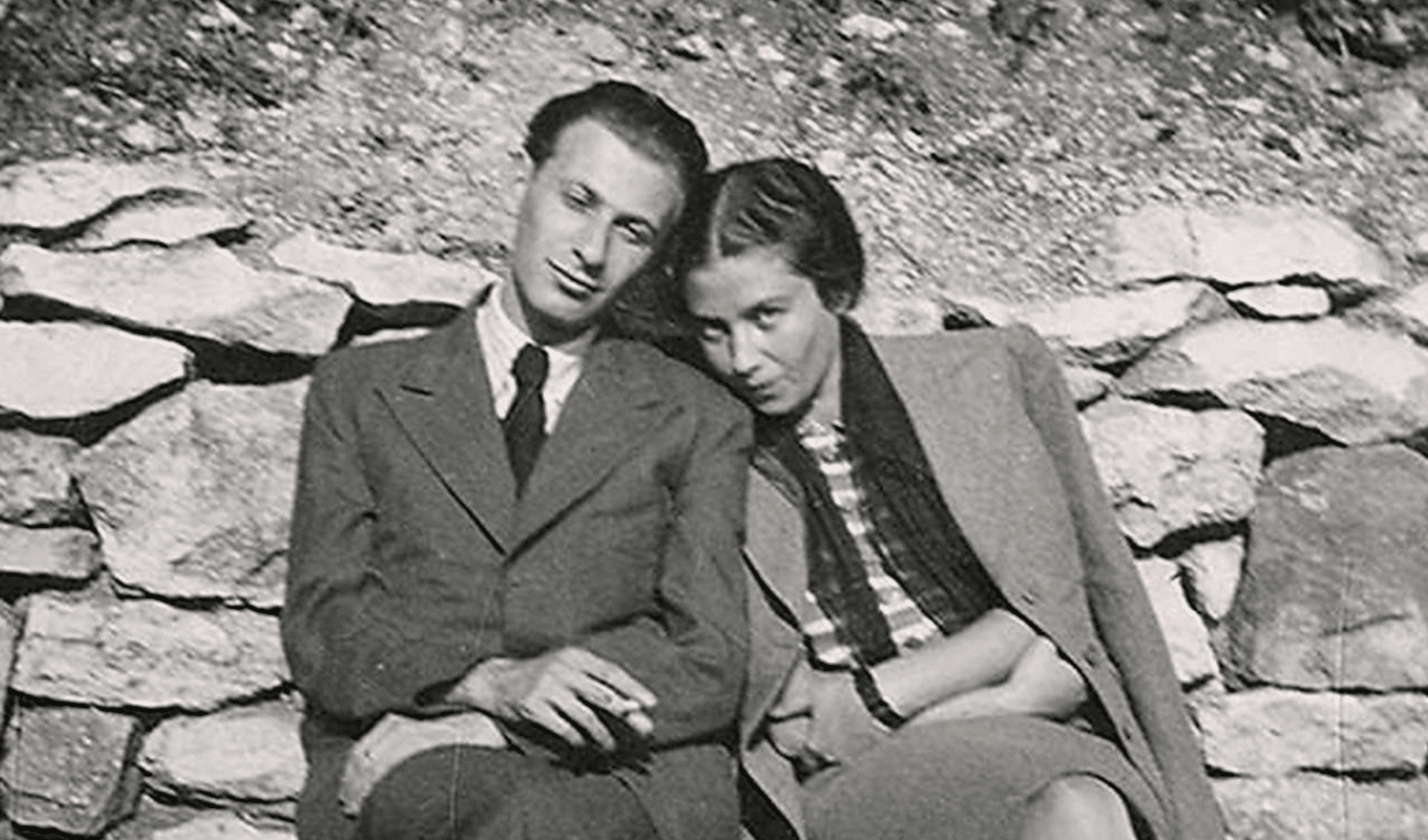Everyone in Hungary knows the name of Miklós Radnóti, the young Jewish Hungarian poet who was murdered during a death march in Western Hungary at the end of the Second World War. This September marked his late widow Fanni Gyarmati’s 110th birthday, whose life leaves plenty to be still explored by historians. A similarly under-researched topic is the reception of Radnóti under socialism. The widow’s recently published diaries[i] cannot fully reveal the Communist distortion of Radnóti’s memory, as they only encompass the period up to 1946, but Gyarmati’s estate, which can be found in the Manuscript Archives of the Library of the Hungarian Academy of Sciences, can help.
Radnóti’s memory was soon hijacked by the Communist Party’s unsolicited worshippers. The Communists were present at Radnóti’s reburial in the autumn of 1946, although at that time they only sent the old family friend, Gyula Schöpflin.[ii] It is telling, however, that the Minister of the Interior, László Rajk, who was not yet a martyr at the time, but was acting as the party’s brutal fist, also expressed his condolences at the reburial—we know that as Gyarmati thanked him for having been there in letter, addressing Rajk as ‘Dear Laci’. [iii] However, only a month later the widow complained to Communist writer István Vas about the ‘lack of sympathy and lack of echo’ regarding her dead husband.[iv]But she also got into a dispute with Vas, who had called Radnóti a ‘pure socialist’ and ‘unexpectedly’ ‘persistent in the defence of Hungarians.’ The widow agreed with the former phrase but had an issue with the ‘unexpectedly’ qualifier. As she wrote, Radnóti wanted to be a poet of the ‘country’, not of an ‘international elite’.[v]
The peace-loving poet would not have supported the horrors of the Rákosi regime
In a certain sense, of course, the poet was a natural choice for Communist memory politics. Radnóti himself had written in an article that Marx had a great influence on him,[vi] and Gyarmati recalled that he always tried to get hold of the writings of Communist intellectuals Sándor Gergely and György Lukács.[vii] In the summer of 1946, when she and Communist Gyula Ortutay—a family friend and Gyarmati’s boss at the time—were still desperately trying to locate Radnóti’s whereabouts, they referred to him in a document simply as ‘the Communist poet and writer’.[viii] However, it is obvious that the peace-loving poet would not have supported the horrors of the Rákosi regime and the bloody crushing of the 1956 revolution, even though he wrote in his diary that ‘anyone who talks too much about “what defines a Hungarian” instead of making art, should be punched in the mouth and have all thirty-two teeth knocked out.’[ix]
While he could obviously no longer issue such a certificate to Radnóti, Ortutay did produce one for Gyarmati, attesting that since 1930 she had ‘actively participated in the illegal Communist youth movements, and from that time on, to the best of my knowledge, she has never for a moment been disloyal to her communist convictions.’ ‘In all her work she has always wanted to serve her Party’, ‘since her husband’s death she has lived only for Party and official work’, ‘in her loyalty and love for the Party she is one of the best characters,’ Ortutay ‘praised’ the widow.[x] Finally, Gyarmati’s background in the movement was confirmed to go back to 1931, and her Party membership was acknowledged from 1945. In her estate, there is also a certificate of attendance of an advanced level Hungarian Workers’ Party seminar.[xi]
But the widow and the Party never truly saw eye to eye. Party membership and ideological training aside, Gyarmati conspicuously distanced herself from the regimes of Rákosi and Kádár, which both used Radnóti’s memory for their own purposes. On the tenth anniversary of Radnóti’s death, the Communist Szabad Nép paper commemorated his death and the Hungarian Writers’ Association held a memorial matinee, but Gyarmati did not attend.[xii] Her attitude did not change in the Kádár era either. In the spring of 1963, she was approached by the Executive Committee of the Budapest City Council to change the name of Izabella Street in the 6th district to Radnóti Miklós Street, and the widow supported the idea—but did not actively pursue the idea. [xiii] When the present Radnóti Miklós Street was named after her late husband in 1969, she stayed away from the inauguration event, according to press reports. Klára Bálint, the widow of the writer Antal Szerb—also a victim of the Holocaust—wrote to Gyarmati on the occasion of the event: ‘Nice, nice, but how is all of this our business? It is very difficult to bear, and sometimes I feel that it would be better if these things were really left to ‘posterity’, and we, the living, did not have to relive the agony over and over again. I am haunted by the obsessive feeling that something that is alive is being taken away from us, from us personally, to be set in stone. Memorials, monuments, streets—we ‘appear’ and ‘behave’ as we are expected to do, and I feel like a circus monkey! I hate all this glory engraved into stone. One word from them, one smile from them could have been the salvation. Salvation—which we shall never have, all efforts are in vain!’[xiv]
Gyarmati did not appear at any of the events
From 1966, the Kádár regime held ‘Radnóti Peace Marches’ from Győr to Abda, which it used to emphasise political slogans of the time: support for the Soviet Union, the Communists of Vietnam and Cambodia, and attacks on West-German ‘fascism’. (The commemoration was all the more cynical as the state police had found Radnóti’s murderers during an investigation between 1966 and 1967, but did not arrest them as some of them had in the meantime joined the Communist party).[xv] Gyarmati did not appear at any of the events, although in 1975 she apparently only cancelled in the last minute: at least this is indicated by the fact that the Győr-Sopron County Committee of the Youth League of the Hungarian Communist Party even sent her instructions on how to get to the venue of the banquet on the day of the event.[xvi] Statues of Radnóti were unveiled in Pécs in 1965, in 1968 in Győr and in 1969 in Csepel, but there is no record of Gyarmati attending any of the unveiling ceremonies—at least there is no trace of her participation in the press or in the papers of her estate.
This does not mean, of course, that the widow disappeared from the public eye. In November 1961, she represented Hungary at a left-wing women’s conference in Berlin, and on her return home she told Népszabadság that ‘I was often with women and girls from West Germany at this conference, and they talked bitterly about how the Horst Wessel song was being sung again in their country, with a slightly altered but no less vile text.’[xvii] In 1964, she represented Hungarian women in London at the invitation of an English women’s organisation.[xviii] In 1972, the Presidential Council of the People’s Republic awarded the widow the Gold Medal of the Order of Labour; in 1976 the Minister of Education awarded her the Apáczai Csere János Award; in 1982 the Presidential Council of the People’s Republic again awarded her the Order of Merit for Socialist Hungary; and finally, in 1987, the President of the Presidential Council, Károly Németh, awarded her the Order of the Flag of the People’s Republic of Hungary.[xix]
In private, however, Gyarmati remained critical of the system’s respect for Radnóti. In 1984, when a historian mentioned that Radnóti ‘received no help from anywhere’ during his last period of labour service, Gyarmati angrily wrote to Vas: ‘where were his … comrades?… is this not a falsification of history?’[xx] Her position was summed up in a letter to Vas in 1964: ‘I don’t know how you feel about immortality, but I would much prefer if he was alive and was lionized by the [press] only much later. But we have no power to change the terrible story. I am 59 years old today. He wouldn’t even be that age’.[xxi]
[i] Fanni Gyarmati (Radnóti Miklósné), Napló 1935–1946, vols. I-II. Bp., Jaffa, 2018.
[ii] Szabad Nép, 17 Aug. 1946, 4.
[iii] MTA Könyvtár Kézirattára (hereon cited as MTAKK) Ms 2676/187. and Ms 2674/102.
[iv] MTAKK Ms 2674/148.
[v] MTAKK Ms 2674/149.
[vi] József M. Pásztor, ’Folyóiratok hasábjain a pályakezdő Radnóti’, Magyar Hírlap, 14 Oct. 1972 (weekend supplement), III.
[vii] MTAKK Ms 2673/65.
[viii] MTAKK Ms 2645/9.
[ix] Radnóti Miklósné (ed.), Radnóti Miklós. Napló, Bp., Magvető, 1989, 138.
[x] MTAKK Ms. 2666/95.
[xi] MTAKK Ms 2666/97. and Ms 2666/93.
[xii] Szabad Nép, 11 Nov. 1954, 3.; Szabad Nép, 22 Nov. 1954, 2.
[xiii] MTAKK Ms. 2667/166.
[xiv] MTAKK Ms 2677/22.
[xv] See the research of Tamás Csapody: https://epa.oszk.hu/00800/00861/00048/pdf/aetas_2010-01_066-092.pdf
[xvi] MTAKK Ms. 2657/41. and Ms 2657/42.
[xvii] Esti Hírlap, 11 Nov. 1961, 6. and Népszabadság, 21 Jan. 1962, 9.
[xviii] Csongrád Megyei Hírlap, 26 May 1964, 3.
[xix] Szocialista Művészetért, 1t Oct 1972, 8.; Esti Hirlap, 4 June 1976, 1.; Csongrád Megyei Hírlap, 10 Sept. 1982, 4.; Magyar Hírlap, 9 Sept 1987, 6.
[xx] MTAKK Ms 2674/151. and Ms 2679/5.
[xxi] MTAKK Ms 2677/105.








